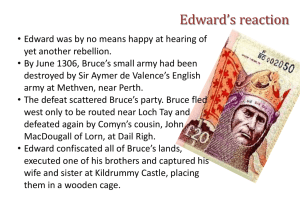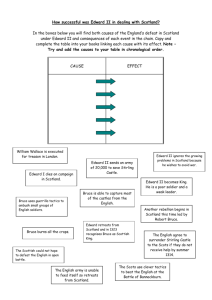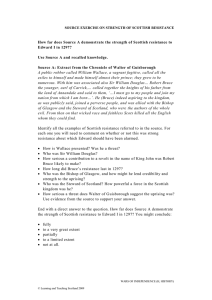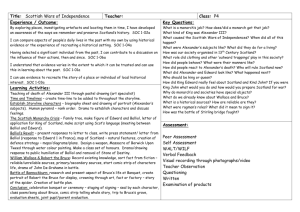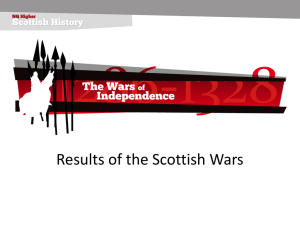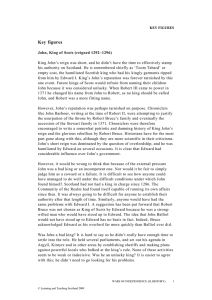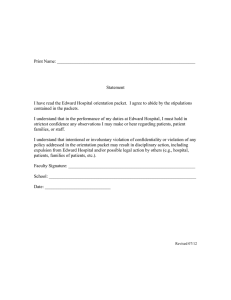Introduction to the Scottish Wars of Independence
advertisement
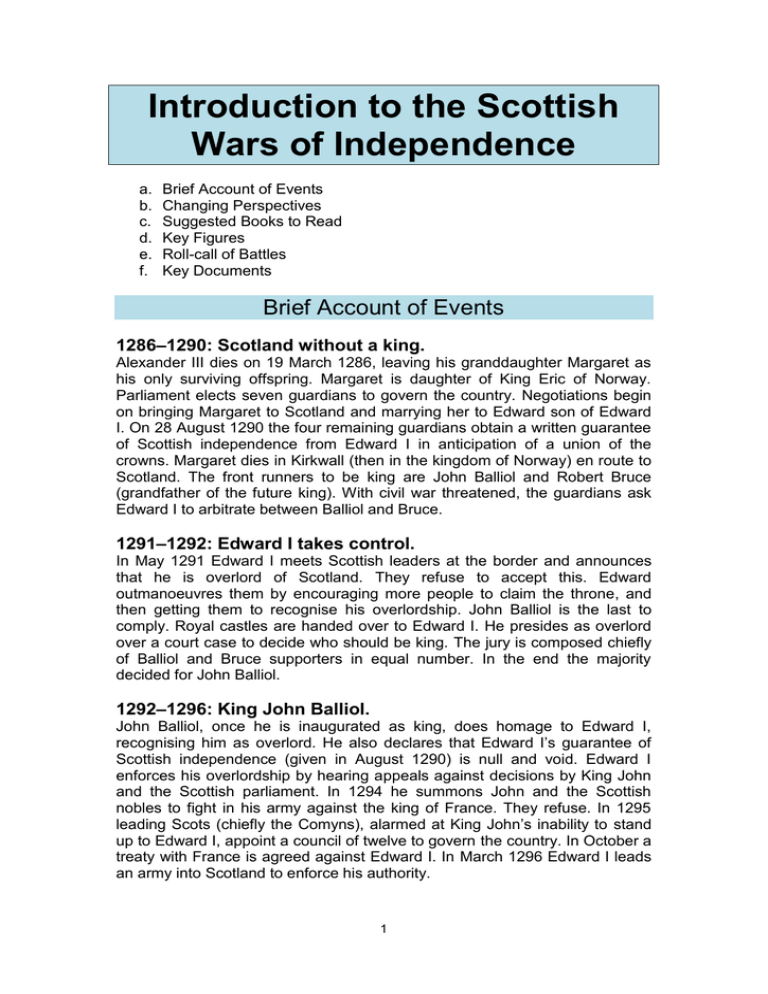
Introduction to the Scottish Wars of Independence a. b. c. d. e. f. Brief Account of Events Changing Perspectives Suggested Books to Read Key Figures Roll-call of Battles Key Documents Brief Account of Events 1286–1290: Scotland without a king. Alexander III dies on 19 March 1286, leaving his granddaughter Margaret as his only surviving offspring. Margaret is daughter of King Eric of Norway. Parliament elects seven guardians to govern the country. Negotiations begin on bringing Margaret to Scotland and marrying her to Edward son of Edward I. On 28 August 1290 the four remaining guardians obtain a written guarantee of Scottish independence from Edward I in anticipation of a union of the crowns. Margaret dies in Kirkwall (then in the kingdom of Norway) en route to Scotland. The front runners to be king are John Balliol and Robert Bruce (grandfather of the future king). With civil war threatened, the guardians ask Edward I to arbitrate between Balliol and Bruce. 1291–1292: Edward I takes control. In May 1291 Edward I meets Scottish leaders at the border and announces that he is overlord of Scotland. They refuse to accept this. Edward outmanoeuvres them by encouraging more people to claim the throne, and then getting them to recognise his overlordship. John Balliol is the last to comply. Royal castles are handed over to Edward I. He presides as overlord over a court case to decide who should be king. The jury is composed chiefly of Balliol and Bruce supporters in equal number. In the end the majority decided for John Balliol. 1292–1296: King John Balliol. John Balliol, once he is inaugurated as king, does homage to Edward I, recognising him as overlord. He also declares that Edward I’s guarantee of Scottish independence (given in August 1290) is null and void. Edward I enforces his overlordship by hearing appeals against decisions by King John and the Scottish parliament. In 1294 he summons John and the Scottish nobles to fight in his army against the king of France. They refuse. In 1295 leading Scots (chiefly the Comyns), alarmed at King John’s inability to stand up to Edward I, appoint a council of twelve to govern the country. In October a treaty with France is agreed against Edward I. In March 1296 Edward I leads an army into Scotland to enforce his authority. 1 1296–1305: Edward I conquers Scotland twice. Scottish knights put up little resistance as Edward I marches through Scotland in 1296, reaching as far north as Elgin. He leaves Scotland in the hands of English officials who face stiff resistance, particularly from William Wallace, and most of the kingdom is liberated. During this period Scots are fighting to restore their king, John Balliol, who Edward had removed. In 1303 Edward I again leads an army to Elgin. In 1304 the Scottish government, led by Balliol’s son-in-law, John (the Red) Comyn, surrenders, and in 1305 Edward settles how a conquered Scotland is to be governed. 1306–1309: Civil war, Bruce v. Comyn. Robert Bruce kills John (the Red) Comyn and seizes the throne, but is soon defeated and flees. He returns in 1307 and begins a highly successful campaign against Scots, led by the Comyns, the most powerful family in Scotland, who regard John Balliol, not Robert Bruce, as their rightful king. Edward I dies in 1307 while leading an army against Bruce. Buchan in the North-East, a powerbase of the Comyns, is ravaged by Bruce’s forces. 1310–1314: Robert Bruce reconquers Scotland. Edward II’s campaign in Scotland fails, and Bruce’s forces capture and destroy all remaining major castles in English hands. Edward II leads another army into Scotland, and is defeated by Bruce at Bannockburn. Bruce is now master of Scotland. 1314–1323: Bruce takes war to England. Edward II of England refuses to recognise Bruce as an independent king. Bruce raids Northern England and his brother, Edward, leads an invasion of Ireland (which was partly an English colony). In 1320 Bruce organises Scottish barons to send a letter to the pope making a powerful case for Scottish independence. (This letter is known as the ‘Declaration of Arbroath’.) But Bruce still faces serious threats. The wounds of the civil war have not healed. In 1320 a conspiracy to kill Bruce is brutally crushed. 1323–1329: Scottish independence recognised. A truce with England begins, and a treaty of alliance with France is agreed. The adolescent Edward III becomes king of England in 1327. Bruce puts pressure on the weak English government, who in the Treaty of Edinburgh (1328) formally recognise Bruce as king of an independent Scotland. Bruce dies in 1329 before hearing that the pope, too, has recognised him as king of an independent Scotland. 1332–1335: Civil war and English occupation. Bruce was succeeded by David II, who was only five years old. By 1332 Bruce’s leading captains were dead. There were still some who supported Balliol not Bruce. John Balliol had died long ago, and his son Edward now came to prominence, leading a band of knights into Fife and briefly becoming king in 1332. In 1333 Edward Balliol returned, this time supported by Edward III. The Bruce party were defeated and many killed. David II was taken to France in 1334. Edward Balliol was again king, and gave over the south of Scotland (including Edinburgh) to Edward III of England. 2 1335-1341: Revival of the Bruce cause. The last Bruce leaders in the field were Robert Stewart in Bute and Andrew Murray in the North. Andrew Murray leads a brutal and successful campaign which turns the tide. In 1337 Edward III turns his attention to invading France, and Edward Balliol looses support and flees. In 1341 David II returns from France. After 1341: Stalemate. The wars never formally end. There was no treaty in which the king of England recognised the king of Scotland as an independent monarch. But conquest was no longer on the cards. The last reigning king of England to invade Scotland was Henry IV in 1400. Some Scottish strongholds near the border remained in English hands. Roxburgh was not finally retaken by the Scots until 1460. Berwick before 1296 had been Scotland’s wealthiest town. Between 1296 and 1482 it was more often in English than in Scottish hands, and after 1482 remained in England. The continuing hostility with England, and England’s long war with France (1337-1453), meant that Scotland became close allies with France. After Henry V of England won the Battle of Agincourt the main force which prevented him from conquering France was a Scottish army which defeated and killed Henry V’s brother at the battle of Baugé in 1421. This Scottish army was eventually defeated and destroyed at Verneuil in 1424. Changing Perspectives Key change Historians have moved a long way from seeing the war in simple terms as Wallace and Bruce versus the English, and seeing Scots who supported the English as traitors. This is because: i. ii. The ‘civil war’ dimension is more openly recognised, especially after 1306. Some Scots, quite naturally, felt they could not change the fact that John Balliol was their king, however hopeless his cause was. For them Robert Bruce was a self-serving usurper. The Comyns, in particular, could not support Bruce after he killed their leader, John (the Red) Comyn. More attention is paid to the period 1296-1305, and particularly the role of the Comyns in leading opposition to Edward I after Wallace’s resignation. Bruce’s achievement reassessed Does this diminish Robert Bruce’s achievement? The fact that not all Scots were convinced that he should be king means that Robert Bruce had to work hard throughout his reign in order to maintain his position. He had to be not only a brilliant military commander but also a masterly politician. It is a measure of his success that, in the end, he was regarded as one of the most famous knights in Europe, not only because of his fighting prowess, but also his demonstration of other chivalric virtues, such as generosity in victory. 3 Patriotism not the only reason to resist English occupation Historians are also more willing to recognise that motives for fighting the English could be complex. A crucial issue is that royal government in England was much more heavy and demanding than royal government in Scotland. The Scots objected to English occupation so strongly because, in part, they were not used to the experience of strong central government. This was particularly true after Edward I’s conquest because Edward, in his desperation for money to finance his war against the king of France, ordered all wool waiting for export to be seized. The wool trade was vital to the Scottish economy, so this measure brought immediate suffering to merchants and better-off peasants with wool to sell, as well as to greater landholders. The leaders of society at all levels (village, locality and region) had a powerful motive to rise against Edward I and insist on the restoration of a Scottish king who would govern Scotland in a much less oppressive way, as of old. William Wallace The film Braveheart is almost entirely fictional. Wallace was no commoner. His father and brother were knights who followed a great noble, James Stewart. It was, however, unprecedented for someone of Wallace’s status to lead a kingdom. He provided leadership at a time when the ‘natural’ leaders in medieval society, the higher nobility, were almost all in Edward I’s power after the conquest of 1296. But he was not alone: Andrew Murray escaped from captivity and led the uprising in the north, and William Douglas led men from the south. Both Douglas and Murray joined forces with Wallace when they launched attacks. Wallace’s first major incident, when he killed the sheriff of Lanark, was also made in partnership with a knight, Richard of Lundie. It seems that, whenever a knight wanted to attack the English occupiers, they looked to Wallace and his band for support as the most effective force. At the famous victory of Stirling Bridge (1297) the army was led by Andrew Murray as well as Wallace. Murray died two months later, leaving Wallace in charge. Wallace was knighted became guardian. This was the first time that the government was led by a single person who was not the king. This led the English to accuse him of acting like a king. Wallace resigned after losing the Battle of Falkirk in 1298. He continued to serve the cause of independence as a diplomat. After the submission of 1304 Edward I refused to make peace with Wallace and demanded that he be hunted down. He was captured a year and a half later and executed in London for treason. Suggested Books to Read Classic studies and texts G. W. S. Barrow, Robert Bruce and the Community of the Realm of Scotland (first published in 1965, new editions in 1976, 1988 and by EUP in 2005) A. A. M. Duncan (ed. and trans.), John Barbour. The Bruce (Canongate, 1997). Alexander Grant, Independence and Nationhood: Scotland 1306-1469 (1984; republished by EUP) 4 Some more recent books Amanda Beam, The Balliol Dynasty, 1210-1364 (John Donald, 2008) Michael Brown, Bannockburn: The Scottish War and the British Isles, 1307-1323 (EUP, 2008) Michael Brown, The Wars of Scotland 1214-1371 (EUP, 2004) Edward J. Cowan, ‘For Freedom Alone’: the Declaration of Arbroath (Tuckwell Press, 2003) Key Figures Edward I, king of England 1272–1307 He was determined to assert what he saw as his rights as king. He limited the power of major landholders, conquered Wales (1282–1283), and resisted the king of France’s authority over Edward’s lordship in Gascony. His military ambitions in Britain and France were a serious financial strain. This was met by unprecedented levels of taxation, which nearly led to revolt in England. Edward II, king of England 1307–1327 Failed to overcome the political and financial problems he inherited from his father, Edward I. He managed to alienate his family, and became increasingly ruthless and oppressive. He was deposed by his wife, and afterwards killed. Edward III, king of England 1327–1377 After supporting Edward Balliol as king of Scots, his attention turned to France in 1337 where he achieved notable military success, although he failed to make real his claim to be king of France. He finally abandoned Edward Balliol in 1350 and recognised David II as king of Scots. David II was at the time Edward’s prisoner. Edward realised that he could achieve more concessions for David’s release if David was treated as a king, not a rebel. Edward Balliol, king of Scots 1332, 1333–1335 The son of King John Balliol, he was raised in England following his father’s capture. His only lands were in France. In 1330 he incurred the displeasure of the king of France and fled. He turned his attention to Scotland and became briefly a successful leader of the ‘anti-Bruce’ cause in Scotland. He clung on in part of Galloway for many years, but was abandoned by Edward III. He died in 1364, over eighty years old. John Balliol, king of Scots 1292–1304 The son of a major English noble, he was one of the main claimants to the throne when the main Scottish royal line died out in 1290. During the first years of his reign he was caught between Edward I’s assertion of overlordship and the determination of Scottish leaders to resist this. When Edward I conquered Scotland in 1296 John was taken to London as a prisoner. Eventually he was released to his ancestral estates in France. A government ruled unoccupied Scotland in his name until 1304, by which time it was clear that John would never return to rule Scotland in person. 5 John (the Red) Comyn, killed 1306 The leader of the most powerful Scottish family, he was prominent in governing unoccupied Scotland. He was the son of John Balliol’s sister. Once it became clear that John Balliol would never return, John Comyn may have been regarded as the best hope for a king of an independent Scotland once Edward I was dead. This may be the reason why Robert Bruce killed him before seizing the throne for himself. Robert Bruce, king of Scots 1306–1329 Earl of Carrick from 1292, when he was 18, and leading figure in governing unoccupied Scotland until defecting to Edward I in 1302 in order to safeguard his powerbase in Carrick. As soon as his father died in 1304 Bruce began planning to take the throne, enlisting the support of the bishop of St Andrews. His killing of John (the Red) Comyn in 1306 made the Comyns his implacable enemies. As king Robert not only took military control of Scotland, but developed parliament as an instrument of his political authority, reforming the legal system in 1318 and expanding the membership of parliament in 1326 to include burgesses (merchants). Roll-call of Battles Dunbar (27 April 1296) Scots host defeated by John de Warenne leading advance force in Edward I’s invasion. Stirling Bridge (11 September 1297) John de Warenne, who Edward I had left in charge of Scotland, defeated by William Wallace and Andrew Murray. Falkirk (22 July 1298) William Wallace defeated by Edward I (but English invasion halted). Roslin (24 February 1303) John Seagrave, commander of English forces in Scotland, defeated by John (the Red) Comyn. Methven (19 June 1306) Robert Bruce defeated by Aymer de Valence, commander of the English forces in Scotland. Loudon Hill (c.10 May 1307) English defeated by Robert Bruce. Inverurie (23 May 1308) John Comyn, earl of Buchan, defeated by Bruce. 6 Pass of Brander (mid-August 1308) John Macdougall of Lorn defeated by Bruce. Bannockburn (23–24 June 1314) Edward II defeated by Robert Bruce. Dundalk (14 October 1318) Edward Bruce killed by English-Irish force. Byland (20 October 1322) John of Brittany, earl of Richmond, defeated by Robert Bruce raiding in Yorkshire. Dupplin (10 August 1332) Donald earl of Mar, guardian for David II, defeated and killed by Edward Balliol. Halidon Hill (19 July 1333) Archibald Douglas, guardian for David II, defeated and killed by Edward III. Culblean (30 November 1335) David Strathbogie (leading supporter of Edward Balliol) defeated and killed by Andrew Murray, guardian for David II. Key Documents Below is a list of the most famous documents that were written during the Scottish War of Independence. For a full text of each, see the sources in the ‘Scottish Government’ resource. Treaty of Salisbury: 6 November 1289 The death of Alexander III on 19 March 1286 had left his infant granddaughter, Margaret, daughter of King Eric of Norway, as heir to the Scottish throne. In April 1289 King Eric sought Edward I’s help in using his position to influence the government of Scotland. It is noticeable that only Eric and Edward referred to Margaret as queen; the guardians who were governing Scotland described her only as ‘lady’. In the treaty it was agreed that Margaret would travel from Norway to either Scotland or England by 1 November 1290. She was not to be married without the will and advice of Edward. Even more ominously, it was agreed that Eric could remove anyone he disliked from the Scottish government, and that if this was objected to, Edward would mediate. He would also mediate if there was disagreement about what was best for ‘reform’ of Scottish government. Although it was Eric, not Edward, who might claim some right to interfere in Scottish affairs in right of his daughter, Margaret (especially if she was regarded as ‘queen’), in the treaty it was Edward who established his first foothold in controlling Scottish affairs. It was stipulated that the treaty should be ratified by the Scots in March 1290. 7 ‘Treaty’ of Birgham-Northampton: 18 July and 28 August 1290 It soon became clear that a marriage would be arranged between Margaret and Edward I’s son and heir, the future Edward II. Had it happened, this would have led to a union of the crowns. The Scottish guardians were in a weak position: the marriage was a matter for the children’s parents, Eric and Edward, not them. Nevertheless, the Scottish guardians embarked on months of negotiations with Edward I in order to safeguard Scottish independence in the event of Edward II becoming their king. A text was agreed with English negotiators at Birgham in July, and was finally issued as a set of undertakings by Edward I at Northampton in August 1290. Edward I thus became the first English king to give a detailed written recognition of Scottish independence. This was a major achievement by the guardians. (It was not, however, a ‘treaty’ but a single-sided statement by Edward I.) On the same day as he gave this written undertaking, however, Edward sent his trusted agent, Bishop Anthony Beck of Durham, to go to Scotland to assist in the ‘reform’ of government ‘according to the kingdom’s laws and customs’. It seems that, although Edward had recognised the independence of Scottish laws and customs, he had his own interpretation of what these laws and customs meant. After Margaret’s death a month later Edward regarded his recognition of Scottish independence as rendered null and void because there would now be no marriage with his son. For the Scots, however, Edward’s solemn undertaking to safeguard Scotland’s sovereignty was a benchmark for justifying their resistance of the king of England’s claim to overlordship. The Great Cause: 17 November 1292 The Great Cause (i.e. the great court case) lasted over a year. A special tribunal was formed, presided over by Edward I as overlord and judge, to determine: 1) if Scotland should be divided among the strongest claimants to the vacant throne, and 2) who should be king. Although Robert Bruce (grandfather of the future king) hired the best lawyers from Paris, the final decision on 17 November 1292 was that Scotland was, as a kingdom, indivisible, and that John Balliol should be king. John Balliol performed fealty to Edward I a few days later, and again after he was inaugurated as king on 30 November, when he also performed homage. A little later he formally released Edward I from his detailed recognition of Scottish independence made in writing at Northampton two years earlier. Franco-Scottish Treaty: 23 October 1295 Edward asserted his authority over Scotland by calling King John Balliol to Westminster to answer appeals against judgments made by King John and the Scottish parliament. This undermining of Scottish independence led Scottish leaders to take control of government in July 1295 and negotiate a treaty of alliance with the king of France, Philip IV, who was then at war with Edward I. By renouncing their homage to Edward, the Scottish leaders and King John made war with Edward inevitable. It has been questioned, 8 however, whether Edward was aware of the treaty until after he invaded Scotland. It is possible that he invaded simply to bring the Scots and their king back to heel for refusing to answer Edward’s summons to them to appear at Westminster to answer to Edward and the English parliament. Scimus Fili : 27 June 1299 In 1299, Scotland north of the Forth was governed by two guardians, Robert Bruce (the future king) and John Comyn (who Bruce killed in 1306). They had succeeded Wallace as guardian the previous year, and governed in the name of the absent King John Balliol. The greatest success in this period was not military but diplomatic. Scottish representatives at Rome persuaded Pope Boniface VIII that Edward I, by invading Scotland, had violated the pope’s rights over Scotland as Rome’s ‘special daughter’. The pope in fact had no such rights: this was a gross misrepresentation of the original meaning of Scotland as Rome’s ‘special daughter’, which referred only to the direct authority of the pope over Scottish bishops without going through an archbishop. The result, nevertheless, was that the pope now backed the cause of Scottish independence against Edward I — a major coup for the Scots. This made Edward realise that he needed to justify his claim to Scotland. In the next couple of years he ordered all the submissions (fealties) that he had received from over 1,600 Scots after the conquest of 1296 to be copied by a notary. This is the document known as the Ragman Roll. Declaration of the Clergy: St Andrews 17 March 1309 (reissued Dundee 24 February 1310) Robert Bruce held his first parliament as king in St Andrews in March 1309. Many Scottish towns and castles were still controlled by Edward II. Robert I had had a few significant successes, however; in particular, he had taken Aberdeen in August 1308. With the assistance of Philip IV of France he had negotiated a truce with Edward from 2 February 1309. This continued until the middle of 1310. Robert I lost no time in summoning a parliament after the truce had been agreed. It was important to use the occasion to justify his position as king. Before Robert seized the throne in March 1306, Scottish independence had been fought in the name of John Balliol. Balliol was still alive in France. The document known as the Declaration of the Clergy is the statement of why Robert Bruce was now king. A remarkable feature is the emphasis on the role of the people, by whose authority he had been raised to the kingdom. The Declaration was intended for an international audience, and for that reason was reissued when a Church Council met in Dundee in February 1310. Declaration of the Arbroath: 6 April 1320 Declaration of Arbroath is a letter to the pope urging him to recognise Scotland’s independence. The pope supported Edward II and had been putting Robert Bruce and his supports under intense pressure. On the face of it the Declaration was a response to this pressure. But the Declaration also had an audience at home, including Bruce’s enemies. Although Robert I was master of Scotland, the future of the Bruce dynasty was uncertain in 1320. His only heir was the infant Robert Stewart. Bruce’s supporters must have worried 9 that, if he died, they would struggle to continue. Bruce’s enemies in Scotland, on the other hand, would have taken heart. Edward Balliol, son of King John Balliol, a young man, had recently arrived in England from France. The Declaration was, in part, written to say to Bruce’s enemies that, even if Bruce was no longer king, his supports would find someone else to lead them as king. The threat to Robert Bruce was a real one. In August 1320 a plot by Balliol supporters to kill Robert I was exposed and harshly put down. 10
